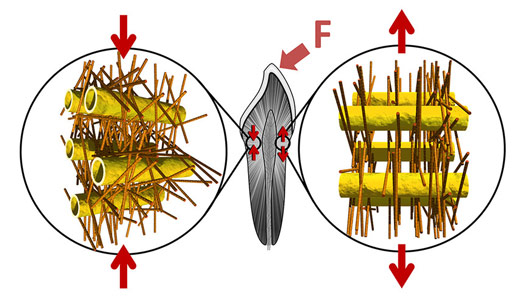- Home
- News
- General News
- Compressed mineral...
Compressed mineral nanoparticles make teeth tougher
10-06-2015
An interdisciplinary team* led by scientists from Charité – Universitätsmedizin Berlin and involving the ESRF has succeeded in unravelling an inbuilt crack-stopping mechanism acting in dentin, the bone-like material that comprises the bulk of human teeth. Unlike normal bone tissue, cracks and damage occurring in dentin do not heal by tissue replacement or remodeling. So how do teeth survive decades of harsh mechanical wear and tear in the mouth? Scientists have now revealed for the first time that the internal stress in dentin acts to prevent damage by stopping cracks from propagating into the interieur of a tooth. These findings have now been published in the materials-science journal Nano Letters.
Human teeth should serve for our entire lifetime despite the daily exposure to damaging forces. Several theories have emerged, attempting to explain why dentin, a bone-like substance that forms the major part of all human teeth, is able to withstand such enormous stress. Now a team headed by Dr. Paul Zaslansky at the Julius Wolff Institute (JWI) of Charité has studied the nanostructure of dentin under various stress conditions. Their findings reveal that the mineral nanoparticles of dentin tightly interact with the dense network of collagen fibres in which they are embedded. The mineral particles become increasingly stressed in reaction to the compression of the fibres. The ensuing internal compression increases the resistance of the tissues to propagation of cracks into the biostructure.
Studying the tiny structures was made possible through access to advanced multi-disciplinary research equipment, capable of generating high-brilliance and high quality synchrotron radiation: the ESRF and BESSY II.
“Specialised high quality and high power synchrotron X-ray techniques were needed, in particular nano-beams that were used to create virtual slices through the dentin showing the local orientation of the mineral nanoparticles. We have developed a number of cutting-edge microscopy techniques exploiting tiny and very intense X-ray beams which are increasingly being used to solve problems in biology and medicine at the new nano-imaging facilities of the ESRF”, says Peter Cloetens, scientist in charge of beamline ID16A-NI.
Engineers use internal stresses to purposely strengthen materials for technical applications, for example in gears or turbine blades. Now it seems that evolution understood this ‘trick’ long ago, and uses this to strengthen our teeth.
The researchers altered the humidity of dentin samples in order to study the underlying stress-generation mechanism. Their measurements showed that the compression occurring in the mineral particles increased when the structural fibres shrank. “The compressed state helps to prevents cracks from developing and we found that compression takes place in such a way that cracks cannot easily reach the tooth’s inner parts, which might damage the sensitive pulp”, explains Dr. Paul Zaslansky of the Julius Wolff Institute of Charité.
In further experiments, scientists demonstrated that heat significantly weakens the link between mineral particles and collagen fibres, which in turn results in a brittle behaviour of dentin. “We therefore believe that the balance of stresses between the particles and the protein is important for the extended survival of teeth in the mouth”, reasons Jean-Baptiste Forien, PhD student and first author of the study. These findings explain why dental prostheses are not as resilient as healthy human teeth: ceramic-based materials are simply too ‘passive’ and do not counteract the stress to which they are exposed. One reason might be that they do not possess the same internal mechanisms employed by the material of the natural tooth. The hope is that the results inspire the development of tougher ceramic structures for tooth repair or replacement.
*Working closely with the DFG funded Charité scientists, the work was made possible through collaboration with researchers from the Technische Universität Berlin, the Max Planck Institute of Colloids and Interfaces, Potsdam, and the Technion – Israel Institute of Technology, Haifa, Israel and thanks to experiments made at the ESRF, European Synchrotron Radiation Facility in Grenoble France and BESSY II of the Helmholtz-Zentrum Berlin für Materialien und Energie.
Publication
J.-B. Forien, C. Fleck, P. Cloetens, G. Duda, P. Fratzl, E. Zolotoyabko, P. Zaslansky, Compressive residual strains in mineral nanoparticles as a possible origin of enhanced crack resistance in human tooth dentin, Nano Letters 15, 3729–3734 (2015).
Links
Julius Wolff Institute for Biomechanics and Musculoskeletal Regeneration: http://jwi.charite.de/
Top image: Nanostructures of dentin. Credit: Jean-Baptiste Forien, © Charité – Universitätsmedizin Berlin.




